|
Joan of Arc (French:
Jeanne d'Arc;
is a national heroine of France and a Catholic
saint. A peasant girl born in eastern France,
Domrémy, to Jacques
d'Arc and Isabelle Romée. Her parents owned about 50
acres of land and her father supplemented his
farming work with a minor position as a village
official, collecting taxes and heading the town
watch.
Jeanne asserted that she had visions from God
that told her to recover her homeland from English
domination late in the Hundred Years' War.
|
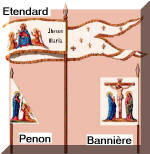 |
 |
|
Pennant of Jeanne
which was never found |
Sword of Jeanne d'Arc |
The French king at the time of Joan's birth,
Charles VI, suffered
bouts of insanity and was often unable to rule. The
king's brother Duke Louis
of Orléans and the king's cousin
John the Fearless,
Duke of Burgundy,
quarreled over the regency of France and the
guardianship of the royal children. This dispute
escalated to accusations of an extramarital affair
with Queen Isabeau of Bavaria
and the kidnappings of the royal children. The
matter climaxed when the Duke of Burgundy ordered
the assassination of the Duke of Orléans in 1407.
The factions loyal to these two men became known
as the Armagnacs and
the Burgundians. The
English king, Henry V,
took advantage of this turmoil to invade France,
winning a dramatic victory at
Agincourt in 1415, and capturing northern
French towns. The future
French king,
Charles VII,
assumed the title of Dauphin
as heir to the throne at the age of 14, after all
four of his older brothers died.His first
significant official act was to conclude a peace
treaty with Burgundy in 1419. This ended in disaster
when Armagnac partisans murdered
John the Fearless
(Jeans-sans-Peur)
during a meeting under Charles's guarantee of
protection. The new duke of Burgundy,
Philippe
le Bon,
blamed Charles and entered into an alliance with the
English. Large sections of France were conquered.
By the beginning of 1429, nearly all
of northern France and some parts of the southwest
were under foreign control. The English ruled Paris,
while the Burgundians controlled Reims. The latter
city was important as the traditional site of French
coronations and consecrations, especially since
neither claimant to the throne of France had yet
been crowned. The English had laid siege to Orléans,
which was the only remaining loyal French city north
of the Loire. Its strategic location along the river
made it the last obstacle to an assault on the
remainder of the French heartland. In the words of
one modern historian, "On the fate of Orléans hung
that of the entire kingdom.
No one was optimistic that the city could
long withstand the siege.
|
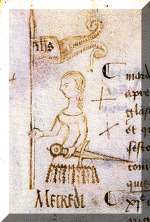 |
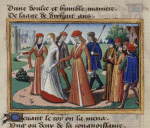 |
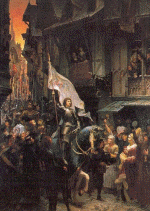 |
|
Sketch representing Joan of Arc,
in a
register of the Parliament of Paris
by Clerk Clément
de Fauquembergue |
Journey of Jeanne to
Chinon
to meet the Dauphin |
Jeanne
d'Arc enters Orléans
painting by
Jean
Jacques SCHERRER, 1887. |
The uncrowned King Charles VII sent her to the siege
at Orléans as part of a relief mission. Joan of Arc arrived at the siege of Orléans
on 29 April 1429. She
gained prominence when she overcame the
dismissive attitude of veteran commanders and
lifted the siege in only nine days.
She overcame this by disregarding the veteran commanders' decisions,
appealed to the town's population, and rode out to each skirmish, where she
placed herself at the extreme front line, carrying her banner. Several more
swift victories led to Charles VII's coronation at Reims
and settled the disputed succession to the throne.
She
led the French army to several important victories
during the Hundred Years' War, claiming divine
guidance.
|
 |
 |
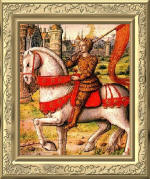 |
|
Jeanne d'Arc
and King Charles VII |
Jeanne d'Arc
Siege of Orléans |
Jeanne d'Arc
|
After minor action at La-Charité-sur-Loire in
November and December, Joan went to Compiègne the
following April to defend against an English and
Burgundian siege. A reckless skirmish on 23 May 1430
led to her being captured. When she ordered a
retreat, she assumed the place of honor as the last
to leave the field. Burgundians surrounded the rear
guard, she was unhorsed by an archer and initially
refused to surrender.
The English government eventually purchased
her from
Jean de Luxembourg for ten thousand écus - to be
tried by an ecclesiastical court.
Joan's trial for heresy was politically motivated.
The duke of Bedford claimed the throne of France for
his nephew Henry VI. She was responsible for the
rival coronation. Condemning her was an attempt to
discredit her king. Legal proceedings commenced on 9
January 1431 at Rouen, the seat of the English
occupation government. The procedure was irregular
on a number of points.
To summarize some major problems, the jurisdiction
of judge Bishop Cauchon was a legal fiction. He owed
his appointment to his partisanship. The English
government financed the entire trial. Clerical
notary Nicolas Bailly, commissioned to collect
testimony against her, could find no adverse
evidence. Without this, the court lacked grounds to
initiate a trial. Opening one anyway, it denied her
right to a legal advisor.
The trial record demonstrates her exceptional
intellect. The transcript's most famous exchange is
an exercise in subtlety. "Asked if she knew she was
in God's grace, she answered: 'If I am not, may God
put me there; and if I am, may God so keep me. The
question is a scholarly trap. Church doctrine held
that no one could be certain of being in God's
grace. If she had answered yes, then she would have
convicted herself of heresy. If she had answered no,
then she would have confessed her own guilt. Notary
Boisguillaume would later testify that at the moment
the court heard this reply, "Those who were
interrogating her were stupefied" and abruptly
halted the questioning for that day. This exchange
would become famous, and is incorporated into many
modern works on the subject.
Several court functionaries later testified that
significant portions of the transcript were altered
in her disfavor. Many clerics served under
compulsion, including the inquisitor, Jean LeMaitre,
and a few even received death threats from the
English. Under Inquisitorial guidelines, Joan should
have been confined to an ecclesiastical prison under
the supervision of female guards (i.e., nuns).
Instead, the English kept her in a secular prison
guarded by their own soldiers. Bishop Cauchon denied
Joan's appeals to the Council of Basel and the Pope,
which should have stopped his proceeding.
|
 |
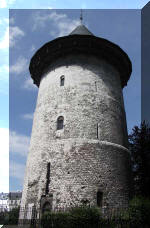 |
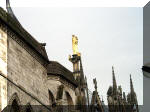 |
|
Castle of
Rouen |
Tower in Rouen - where
she might have been imprisoned |
|
The twelve articles of accusation that summarize the
court's finding contradict the already-doctored
court record. Illiterate Joan signed an abjuration
document she did not understand under threat of
immediate execution. The court substituted a
different abjuration in the official record.
Heresy was a capital crime only for a repeat offense.
Joan agreed to wear women's clothes when she
abjured. A few days later, according to
eyewitnesses, she was subjected to an attempted rape
in prison by an English lord. She resumed male
attire either as a defense against molestation or,
in the testimony of Jean Massieu, because her dress
had been stolen and she was left with nothing else
to wear.
Eyewitnesses described the scene of the execution on
30 May 1431. Tied to a tall pillar, she asked two of
the clergy, Martin Ladvenu and Isambart de la
Pierre, to hold a crucifix before her. She
repeatedly called out "in a loud voice the holy name
of Jesus, and implored and invoked without ceasing
the aid of the saints of Paradise." After she
expired, the English raked back the coals to expose
her charred body so that no one could claim she had
escaped alive, then burned the body twice more to
reduce it to ashes and prevent any collection of
relics. They cast her remains into the Seine. The
executioner, Geoffroy Therage, later stated that he
"...greatly feared to be damned for he had burned a
holy woman.
Jeanne d'Arc was burned at
the stake 30 May 1431
nineteen years old.
|
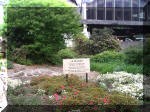 |
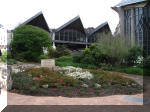 |
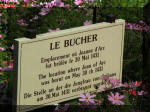 |
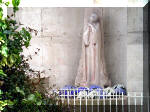 |
|
Rouen
place where Jeanne died |
|
location where Jeanne died |
|
Twenty-four years later, on the initiative of
Charles VII, who could not possibly afford being
seen as having been brought to power with the aid of
a condemned heretic, Pope Callixtus III reviewed the
decision of the ecclesiastical court, found her
innocent, and declared her a martyr.
She was beatified in 1909 and later canonized
in 1920. She is one of three patron saints of France.
Joan of Arc was not a feminist. She operated within
a religious tradition that believed an exceptional
person from any level of society might receive a
divine calling. She expelled women from the French
army and may have struck one stubborn camp follower
with the flat of a sword. Nonetheless, some of her
most significant aid came from women. King Charles
VII's mother-in-law,
Yolande of Aragon, confirmed
Joan's virginity and financed her departure to Orléans. Joan of Luxembourg, aunt to the count of
Luxembourg who held custody of her after Compiègne,
alleviated her conditions of captivity and may have
delayed her sale to the English. Finally, Anne of
Burgundy, the duchess of Bedford and wife to the
regent of England, declared Joan a virgin during
pretrial inquiries.For technical reasons this
prevented the court from charging her with
witchcraft. Ultimately this provided part of the
basis for her vindication and sainthood. From
Christine de Pizan to the present, women have looked
to her as a positive example of a brave and active
female. |
